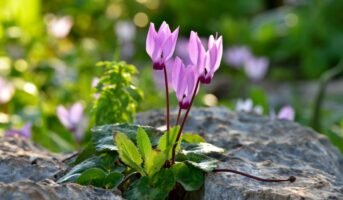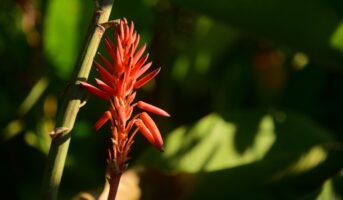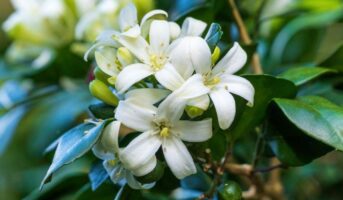A striking tiny plant with colourfully variegated leaves that stand out against most other vegetation is the polka dot plant (scientific name: Hypoestes phyllostachya). The most well-known polka dot plants have green dots on a pink backdrop on their leaves. A number of spotted or mottled varieties with purple, white, red, and other darker hues, as well as a greater contrast, make the plants stand out even more.
Since they are indigenous to warm climates and are not very difficult to manage, many gardeners consider them annuals and replace them with new plants every year. They should be sown in the spring. They may also be grown in pots as houseplants. They have, however, grown invasive and have spread widely in Australia, where they are considered a weed.

Source: Pinterest
see also: alla about Chromolaena Odorata
Polka dot plant: Facts
| Botanical name: Hypoestes phyllostachya |
| Type: Evergreen shrub |
| Flower: Yes |
| Varieties available: four |
| Also known as: Polka Dot plant |
| Height: 12 inches tall |
| Season: Throughout the year |
| Sun exposure: Keep in the shade with a few hours of direct sunlight |
| Ideal temperature: 70 to 90 degrees Fahrenheit |
| Soil type: Well-drained |
| Soil pH: Slightly acidic |
| Basic requirements: Intermittent watering, indirect sunlight, home-made fertiliser |
| Ideal location for placement: Indoors |
| Ideal season to grow: Entire year |
| Maintenance: Low |
see also: about Acalypha Wilkesiana
Polka dot plant: Types
- Carmina has leaves that are dark green with red spots.
- Confetti provides leaves that are green with white, pink, rose, crimson, or burgundy dots.
- Pink Brocade has green leaves with pink dots scattered throughout.
- Splash The series has leaves with pink, crimson, or white spots scattered throughout various shades of green.
Polka Dot plant step by step care guide
- Light: Outside, polka-dot plants prefer a spot with some shade. To avoid the deterioration of the leaf colours and loss of the plant’s ornamental value, choose a planting place that receives neither too little nor too much light. Bright, indirect lighting that comes from an east or south-facing window should be used in rooms.
- Watering: If there isn’t enough rain, prepare to water frequently.
- Humidity: Warm, humid climates are necessary for polka dot plants to flourish. When growing indoors, it has to have a humidity level of minimum 50%. To increase humidity, you can place potted plant in a water tray with pebbles or mist the polka dot plant leaves.
- Temperature: When growing indoors, Polka dot plant should have an average air temperature of 70° to 75°F.
- Feeding: The Polka Dot plant needs frequent feedings during the entire growing season from spring to October.
- Repotting: Polka dot plants favour organically rich, well-drained soil. Usually, these plants do well in an all-purpose organic potting mix. To enhance soil drainage, use some pumice or perlite. Spring, after the dormant period is the best time to repot a polka dot plant.
- Speed of Growth: Polka dot plant takes 2-4 months to grow from germination to a full fledged plant.
- Height / Spread: Polka dot plant can grow upto 3 feet in height.
- Pruning : To prevent the plant from growing long, lanky branches, you’ll need a pair of clean, sharp scissors or pruning shears. Weekly cutting or pinching back of the top two leaves on each stem will encourage a bushier growth habit. Trimming actively can encourage the plant to develop more robustly and healthily. Although blooms are pretty, it’s ideal to cut them back as soon as they begin to appear to prolong the polka dot plant’s growing season. In any case, the blossoms aren’t as decorative as the leaves. Once the plant has done flowering, it will either die off or go into hibernation.
- Propagation
How to grow the plant from cuttings?
- You can grow the polka dot plant from seed, but it’s best to start with a cutting.
- Cuttings are easier to root than seeds and will give you a faster start.
- You can take cuttings from the main stem of the plant or root new plants from the bottom of a container.
- Cuttings can also be taken from juvenile plants, i.e. the youngest parts of the plant that haven’t yet bloomed.
- Rooting hormone is necessary for the successful propagation of the polka dot plant. You can get rooting hormone at your local garden centre or home improvement store, or online.
- Once you’ve got your cutting in its container, top it with soil and keep it moist until it roots down properly, which usually is within 10 days.
- Then put the container somewhere sunny but not directly in full sun, around six hours per day. The ideal temperature range is between 19-27 degrees Celsius.
How to grow the plant from seed?
- Polka dot plant is a perennial plant that can be grown from seed. The seeds are small and should be planted in early spring. It takes about 4 weeks to germinate, but the plant will take up to 8 months to mature.
- When planting the seeds, you should keep them moist for about 1 week before planting them in a prepared seedbed. Make sure that there is good drainage in the area where you will be planting them.
- After planting, water regularly so that the soil does not dry out too much. You should also provide some nutrients, such as fertiliser and compost, to help support the plant’s growth.
- You should do this every month or so until your plants grow large enough to transplant outdoors in their final location. Where they will remain for several years before dying off naturally by wintertime.

Source: Pinterest
Polka Dot plant flowering season
Polka dot plant flowers in summer season
Arbitrarily, polka dot plants typically bloom in the summer with tiny spikes of lilac or pink flowers. Pinch off the bloom spikes to direct the plant’s energy toward growing its vibrant leaves.
Growth Expectations
Polka dot plant grows well if kept in warm and humid place and supported with good amount of water and care.
Best companion plants for Polka Dot plant in the garden
Impatiens
These are annual flowering plants that love to grow in shade. Since the leaves of polka dot plant are larger, they grow well under these plants.
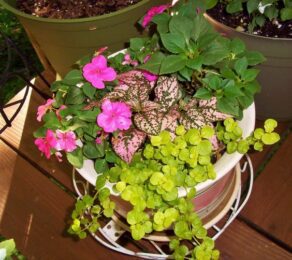
Source: Pinterest
Wishbone flower
As these flowers also prefer shade over sun, they make good companion plants for polka dot plant.
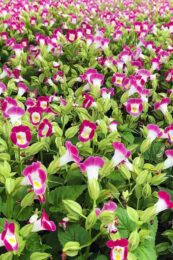
Source: Pinterest
Anthurium
Anthurium makes a great companion plant to Polka dot plant. The heart shaped red flower plant makes that part of your card very rich by its presence.
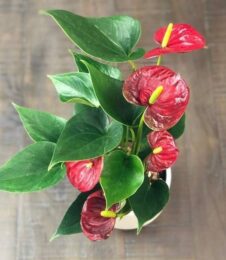
Source: Pinterest
English Ivy
English Ivy is a very easy to maintain plant that can be grown in multiple ways. It grows along Polka dot plant very easily.

Source: Pinterest
Best locations to plant Polka Dot plant
Polka dot plants loves shade and so when you plant a Polka dot plant outside, plant where you get lot of shade. However, it does require light and so a place where it gets indirect light will be perfect. If you look at planting it inside your house, east- or south-facing window is ideal as here you get bright indirect light.
Best times to plant Polka Dot plant
Polka Dot plant grows best when planted in spring just after the winter frost. They love humidity and so the humidity levels should be well maintained while planting them. To increase the humidity of Polka dot plant, you can moist leaves of the plant. Also, humidity can be increased by placing the polka dot plant pot in a tray of water. Note that only the pot should touch and the roots should not.
Polka dot plant: Typical pests and plant illnesses
Mealybugs, aphids, and whiteflies are typical pests that like polka-dot plants. Root rot, leaf spot infections, and powdery mildew are common illnesses that affect polka dot plants. Telltale symptoms of these pest infestations or diseases include discoloured foliage, leaves with holes that generally seem unhealthy, and little insects moving on the plants. Once you’ve established the ideal growth conditions for polka dot plants, they are rather simple to cultivate.
Polka dot plant: Benefits
Polka dot plant is an excellent indoor plant that can help purify the air, improve your mood, enhance the aesthetics of your home, and reduce stress.
Looking at this beautiful plant will help you channel your inner creativity and make you more productive. Overall, this plant is not just pleasing to the eye but will also help improve your health.
Is the polka dot plant toxic?
No, the polka dot plant is non-toxic to humans and animals.
FAQs
Are polka dot plants simple to maintain?
Plants with polka dots are simple to care for and spread. It might occasionally be challenging to create the ideal growth conditions, but once established, it typically works out fi
How quickly does the polka dot plant expand?
These plants develop at a modest rate, but they can be fussy about their growing circumstances and can often slow down if they aren't ideal.
Housing News Desk is the news desk of leading online real estate portal, Housing.com. Housing News Desk focuses on a variety of topics such as real estate laws, taxes, current news, property trends, home loans, rentals, décor, green homes, home improvement, etc. The main objective of the news desk, is to cover the real estate sector from the perspective of providing information that is useful to the end-user.
Facebook: https://www.facebook.com/housing.com/
Twitter: https://twitter.com/Housing
Email: [email protected]



